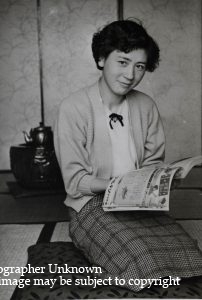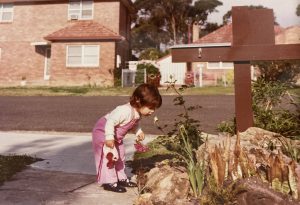Quiet Clues, Quiet Traces: Mayu Kanamori and the Untitled.Showa project
It’s late May, and I’m out walking in my neighbourhood on the day before a council clean-up. Abandoned household objects line the streets: broken drawers, battered lounges, tired whitegoods. A clumsy catalogue of life detritus on display to all who pass by.
The red-brick apartment block I can see from my window has its own pile out front. Among the discards are several neat stacks of magazines. Passing, I glance at the closest cover; to my surprise, it’s in Japanese. I look at the others. There must be at least seventy magazines in total, and they’re all Japanese. In six years of living in this suburb I’ve never noticed a Japanese neighbour. How have these traces of Japan come to arrive here, in this pile of forsaken objects, on the streets of inner western Sydney?
I’m conscious of invisible threads connecting me to the unknown magazine reader, with whom I share Japanese literacy (albeit sometimes faltering), whose apartment block I can see from my own, and whose path has almost certainly crossed, unnoticed, with mine in the process of going about our daily local lives. I venture back later that day and the magazines are gone. Perhaps someone else who reads Japanese has picked them up, speaking to yet more invisible threads linking both the magazine reader and I to another unknown Other in the neighbourhood.
It’s quiet traces like these that Japanese Australian artist Mayu Kanamori illuminates in her work: the ways that the pasts, presents and futures of disparate people connect, ever so subtly, at that grainy boundary where the everyday becomes a story, and a story becomes the everyday. Mayu’s latest project, Untitled.Showa, is no exception.
Untitled.Showa is an online exhibition of what appears to be a collection of family photographs which takes the unusual angle of asking viewers to assist in identifying the subjects. The project was born when Mayu, by chance, came across several bags of photographs from Showa-era Japan at a market in Geelong. They had arrived in the seller’s hands from an unknown deceased estate, with no hard clues as to who the subjects might be, where they are now, or how their likenesses emerged in a time and place so at odds with when and where they were produced. Moreover, there is no suggestion of an Australian tie in any of the images, compounding the mystique. Untitled.Showa represents a quest to return the photographs to a rightful owner, and in the process to unravel the day-to-day tangle of invisible threads that somehow tie pre- and postwar-era Japan to present-day regional Victoria.
Characteristically of Mayu, this project centres on photographs: the medium is arguably her first love. But also characteristically, it is the context of the photographs rather than the subjects themselves that has captured Mayu’s imagination. In her essay On Photography, Susan Sontag writes that “Photographs furnish evidence” (5). She makes this point with respect to the subjects of photography, discussing the importance of photographs as proof of the events they depict. However, Mayu figures the photographs in Untitled.Showa as evidence of a different kind: evidence of encounters between people and places beyond the sphere of the photograph’s production; evidence of the intertwined lives and loves that have acted outside of the frame to catalyse the photographs’ eventual movement across borders.
As such, Mayu considers the photographs first and foremost as objects. It is their links to place and time, both then and now, that produce the twin pulls of poignancy and possibility around which Untitled.Showa is formed. More specifically, it is the disjuncture between the time and place of their creation in the private sphere and the time and place of their emergence into the public realm, newly orphaned and transformed from mementos into commodities, that was the project’s starting point. Where the endpoint will lie remains to be seen. But for now, the photographs have done well to find Mayu: they could not have hoped for a more respectful custodian.
* * * * *
It’s a strange feeling, looking through these photographs in a public forum. We know neither the people nor the places, but nevertheless the images are familiar terrain: beachside happy snaps; commemorations of family gatherings; children coming of age; new babies and proud parents. Holiday photos seem to be frequent, yet the absence of touristic trophy shots of landscapes and landmarks is notable. There is care evident in the untiring focus on faces over places, and the mix of spontaneity and intention. It suggests that these photographs were personal, private objects made for sharing with an inner circle of close contacts, for the then-present and for posterity. However, as often happens, the trajectory of these photographs has not moved according to plan. The once-imagined connection with posterity has been ruptured, leaving behind a lingering pathos as those warm smiles face out into a vacuum, an audience of strangers. We can’t help but feel sadness for them, these lost things.

Untitled.Showa Found Photograph # 017 ファウンドフォト# 017 Photographer Unknown 撮影者不明
The sense of intimacy conveyed by the images is one of the most captivating aspects of the Untitled.Showa exhibition. A few photos in particular stand out, the handful telling the story of the whole. In #017, the mischievous giggle of an older woman is matched with a blurred focus, a likely artefact of the photographer laughing together with her at the same joke, happily unsteadying the camera. The woman’s white work apron and the fusuma doors behind her mark the domesticity of the scene. Unlike many of the other images in the collection, here there’s no static pose nor celebration finery, no clear occasion being commemorated, no holiday or workday best being worn. This photograph instead memorialises the warmth of the relationship between the photographer and the subject in the context of the everyday. #189 is similar in its domesticity. A young woman looks up from reading a magazine, simultaneously bashful and good-naturedly defiant. Her steady eye holds the eye of the photographer, who returns the steadiness with a firm focus in the shot. There’s a palpable intimacy here too; this photograph captures one side of a mutual gaze that was shared with a trusted counterpart, not posed for an outsider like you or me.

Untitled.Showa Found Photograph #189 ファウンドフォト#189 Photographer Unknown 撮影者不明
Not all of the photographs represent everyday moments. Many are tied to a clear occasion—a holiday, a family gathering. Many are posed: moments of choreographed stillness, disrupting the occasions they are intended to memorialise and thereby becoming occasions in and of themselves. But even so, the sense of occasion does not necessarily make them any less intimate. In #191, a teenage girl dressed in finery stands tall, hands clasped in front of her, on a gravel road. The contrast between her formal dress and the informal setting is surprising. She is seemingly on her way to a formal event, but rather than memorialising the event at the destination itself, the photographer has chosen instead to take this photo on the journey there. On the quiet road, the camera is free to focus on the girl alone, with no unknown others to distract or clutter the frame. There is undisguised happiness on the girl’s face and her straight white teeth show in a broad sunny smile, flouting the conventions of formal photos where smiles are rare and teeth are generally not shown. Despite her formal clothing, the image is less about the occasion itself than it is about capturing the girl’s glee in response to the occasion, and the joy and anticipation she no doubt shared with the photographer as they made their way to their destination together.

Untitled.Showa Found Photograph #191 ファウンドフォト#191 Photographer Unknown 撮影者不明
Plenty of others are similarly eye-catching in their intimacy: a woman smiling broadly as she holds a small child in #103 and #104; a couple posing somewhat shyly in #271; and the young women in the Daiei Studios series, their linked arms displaying an affectionate camaraderie. Cataloguing these brings to the fore a second striking aspect of these photographs, which is that they primarily feature women and children: arguably the core of family life, yet often written out of history. In the attention they give to women of multiple generations—and particularly to women as mothers—as well as children, these photographs speak to a gap between the kinds of images and stories that tend to be preserved and highlighted in public fora, and the kinds of images and stories that are central to our daily lives.

Untitled.Showa Found Photograph #103 ファウンドフォト#103 Photographer Unknown 撮影者不明

Untitled.Showa Found Photograph #104 ファウンドフォト#104 Photographer Unknown 撮影者不明

Untitled.Showa Found Photograph #271 ファウンドフォト#271 Photographer Unknown 撮影者不明
Family photos spend most of their time packed away, hidden in dusty boxes that are rediscovered when we move house, or saved in external hard drives tucked away in poky corners of unused drawers. Perhaps the Untitled.Showa photos are being viewed now more than they have ever been. Perhaps they are more complete with an audience, even if the audience is not the familiar eye for which they were intended. Perhaps no rightful owner will emerge, but perhaps that won’t mean the end of this story, because there are invisible threads that now tie us, too, to these photographs. Perhaps in reminding us that somewhere, in a closet or garage, our own family photos exist, and perhaps in inspiring us to revisit and share them with our own inner circles while we can, they have already fulfilled their destiny.
* * * * *
5月下旬、粗大ゴミ収集の前日、近所を歩く。放置された家庭用品が路上に並ぶ。壊れた引き出し、ボロボロになったソファ、くたびれた冷蔵庫や洗濯機。不器用な目録ように生活の残滓が通りすがりの者たちの前に展示されている。
家から窓越しに見える赤煉瓦のアパートの前にも、ゴミの山がある。廃棄物の中には、雑誌が数冊、きちんと積み上げられている。目についた表紙を見ると、驚いたことに日本のものである。他の雑誌にも目を通す。少なくとも全部で70冊はある。この郊外に6年も住んでいるけれど、日本人の隣人に気がついたことは一度もない。シドニーのインナーウェストの通りにある見捨てられたものの中に、日本の痕跡がどのようにしてやって来たのだろうか。
そう思いいたると、未知の雑誌読者と私をつなぐ目に見えない糸が感じられて不思議な気持ちになる。日常の生活の過程で、知らずにすれ違ったこともあろうその人は、自分の家の目と鼻の先にあるアパートの一室に住み、私と日本語の理解力という共通項があるのだ。その日のうちに戻ってみたが、雑誌はもうなくなっていた。もしかしたら、日本語を読める他の誰かに拾われたのかもしれない。未知の雑誌読者と自分、そしてまた、近所に住む別の未知の他者との間にさらに多くの見えない糸の結びつきが語りかけてくるようだ。
ジャパニーズ・オーストラリアン・アーティスト、金森マユの活動はこのような静かな痕跡に光を当てる。日常が物語になり、物語が日常になる粒状の境界線で、異なる人々の過去、現在と未来が、ごくかすかに結びつく。マユの最新作品、『Untitled.Showa』も例外ではない。
『Untitled.Showa』は家族写真集のようだと思えるものをネットで公開し、鑑賞者にそこに映る人の身元確定のための助力を得ると言う、珍しい角度から進められている。このプロジェクトは、偶然にもマユがジーロングの市場で日本で撮影された昭和時代の写真を何袋も見つけたことから生まれた。それらの写真は、持ち主不明の遺留品として売り手の手に渡り、被写体が誰なのか、今どこにいるのか、撮影された時代や場所とは異なる時代や場所、これらの写真がどうやって出現したのか、明確な手がかりはない。さらに、オーストラリアとの繋がりを明確に示唆する画像が一つもなく、そのことが、これらの写真の神秘性を高めている。『Untitled.Showa』は、写真を正当な所有者に返却する過程で、戦前・戦後の日本と現在のビクトリア州の地方都市を結びつける見えない糸の絡まりを解き明かしていくことを意味している。
このプロジェクトはマユの仕事に特徴的なことだが、写真を中心としている。しかし,マユの想像力をかきたてるのは,被写体そのものではなく,写真の文脈であることも特徴的である。スーザン・ソンタグは著書『写真論』の中で『写真は証拠を提供する』と書いている。この点を写真の被写体について論じ、写真が描いた出来事を証明するものとしての写真の重要性を述べている。しかし、マユは『Untitled.Showa』の写真を、その制作領域を超えた人と場所との出会いの証拠、絡み合った人生やその愛情が写真の枠の外で行動し、国境を越え、最終的に移動するきっかけとなったものという異なる種類の証拠として捉えている。
このように、マユは写真をまず第一に物体として捉えている。それらの場所と時との繋がりが、当時も今も痛ましさと可能性と言う二方向の引力を創り、『Untitled.Showa』を形成している。より具体的に言えば、私的な領域での撮影の時や場所と、公共の領域へ顕在化する時期と場所の分断こそがこのプロジェクトの出発点となった。終点がどこにあるのかは、まだわからない。しかし、今のところ、写真はマユを見つけてよかったと言える。彼女ほど丁寧な保管者は望めない。
公の場で写真を見ていると、何だか不思議な気持ちになる。写っている人も場所も知らないのに、海辺での気楽なスナップや家族の記念写真、成年期を迎える子供たち、生まれたばかりの赤ちゃんや誇らしげな両親など見慣れた風景が映し出されている。旅行先での写真が多い中、風景や目印となる物を撮影した観光写真に多い戦利品のようなものがないことがかえって目立つ。あくまでも、場所よりも顔に焦点を当ており、自発性と意思の混合の中に愛情が伺われる。これらの写真は親しい人たちと共有するために、当時と現在、そして後世のために撮影された個人的で私的なものであることを示唆する。しかし、良くあることではあるが、これらの写真の軌跡は計画通りには進まなかった。かつて想定されていた後世とのつながりが断ち切られ、痛恨の余韻にも見える温かな笑顔が、見ず知らずの観客と言う真空に向けられている。私たちは迷子に思いを寄せるように、その写真たちへの哀しみを感じずにはいられない。
画像から伝わってくる親近感は『Untitled.Showa』展の最大の魅力の一つである。その中でも特に目を引く、全体を物語る数葉の写真がある。#017は、年配の女性のお茶目な笑い顔と焦点がぼやけていることがよく合っている。撮影者が女性と一緒に同じ冗談に笑い、その楽しさで(思わず)カメラを揺らしたことが絶妙の効果を生んでいる。白い割烹着とその後ろにある襖が、家庭的な雰囲気を表している。このコレクションの他の多くの写真とは異なり、ここには静止ポーズや晴れ着もなく、明確な記念日もなければ、休日や仕事のためのスーツもない。この写真は、写真家と被写体の間にある日常の文脈の中での関係の温かさそのものを物語っている。#189も同じような家庭的な雰囲気を持つ。若い女性が読んでいる雑誌から顔を上げ、恥ずかしそうな、軽くとがめるような、しかし好意に満ちた眼差しを同時に表している。彼女のそのブレのない視線は写真家の目を捉え、写真家もその目に焦点を合わせて応え、そのことが二人の間の揺るぎない信頼関係を示している。この写真は私たちのような部外者のためにポーズをとったのではなく、信頼できる互いの視線の一面を捉えたものなのだ。
すべての写真がこうした日常の瞬間を表しているわけでもない。多くは、休日や家族の集まりなど、明確な行事と結びついている。多くはポーズをとっている。記憶にとどめようとする行事の現実場面では邪魔かもしれないが、写真のために静止する瞬間は、写真そのものの中と同時にそれを超える特別の場面になっている。しかし、行事の感覚があるからといって、親密さが損なわれるわけではない。#191では、10代の少女が砂利道で両手を組んで背伸びしながら立っている。彼女の正装と日常的な背景とが驚くほど対照的である。なんらかの正式行事にでも向かっている様子だが、写真家はこの写真を、その行事の目的地を記憶化するのではなく、そこに向かう行路で撮影することを選んだ。静かな道で、カメラは彼女一人にピントを合わせることができ、他の未知の者に紛らわされたり、フレームを乱されたりすることはない。少女の表情はあからさまな幸せを表し、その大らかな晴れ晴れしい笑顔からは真直な白い歯が並び、笑顔も歯も見せない通常のフォーマル写真の習慣を無視している。正装にもかかわらず、画像が捉えているのは、その日の行事よりもその日の出来事に対する少女の歓喜と、撮影者と共に目的地に向かいながら共有したと思われる嬉しさや期待感だ。
他の多くの写真でも、同じような親密さに目を奪われる。#103と#104は小さな子供を抱きながら、大きく微笑む女性、#271はやや恥ずかしそうにポーズをとっているカップル。そして『大映スタジオ』シリーズの若い女性たちは腕を組んで、信愛に満ちた仲間意識を示している。全体を見ると、これらの写真の第二の印象的な側面が浮かび上がってくる。歴史から抹消されがちな、しかし家族生活の核心とも言える女性や子供が主役だと言うことだ。複数の世代にわたる女性、特に母親としての女性や子供たちに注目することで、公的な場で保存され強調されがちな画像や物語と私たちの日常生活の中心となる画像や物語との間の相違を、これらの写真は物語っている。
大抵の家族写真は梱包され埃をかぶった箱の中に隠され、引っ越しの際に再発見されたり、使われていない引き出しの隅にしまってある外付けハードディスクに保存されたりしている。もしかしたら、『Untitled.Showa』の写真は、今まで以上に頻繁に見られるようになったのかもしれない。たとえそれが意図された慣れ親しんだ視線でなくても、観る人がいることによりその使命をより全うしているのかもしれない。正当な所有者は出てこないかもしれないが、それがこの物語の終わりを意味するものではない。なぜなら、今や私たちとこれらの写真を繋ぐ眼に見えない糸が存在しているからである。押し入れや物置のどこかに自分たちの家族の写真があることを思い起こし、可能なうちに内輪の人達と共有したいと思わせてくれることで、そんな使命を既に果たしているように思える。
Posted July 2020
2020年7月投函
Elicia O’Reilly

Elicia O’Reilly / Artist supplied エリーシャ・オライリー / アーティスト提供

Elicia O’Reilly / Artist supplied エリーシャ・オライリー / アーティスト提供
Elicia O’Reilly is series editor of the journal New Voices in Japanese Studies and a cultural programmer at The Japan Foundation, Sydney. She has produced exhibitions, talks, story readings and roundtables on themes as diverse as Japanese tattoo, horror manga and the supernatural, gender and student mobility, and has also programmed events for the Art Gallery of NSW. Her personal and professional connection with Japan spans twenty years, eleven of which she spent in Japan working for organisations including Tokyo National Museum and Toyota. She has degrees in literature and communications, and prior to her current role has worked as a publicist, writer, editor and translator.
エリーシャ・オライリーは国際交流基金(シドニー)の文化事業担当であり、New Voices in Japanese Studiesの編集主任である。彼女がこれまでに企画した事業には、日本の刺青、怪奇漫画とスーパーナチュラル(妖怪)、ジェンダー、学生の移動性などがあり、様々なテーマで展覧会、トーク、朗読会、座談会などを行っている。また、その一環としてNSW州立美術館でのイベントの企画もしている。仕事でも個人的にも日本との関わりは20年に及び、そのうち11年間は日本に滞在して、東京国立博物館やトヨタに勤めていた。文学とコミュニケーションの学位を取得し広報業務、文筆家、編集者及び翻訳者の経験がある。
Recent Comments